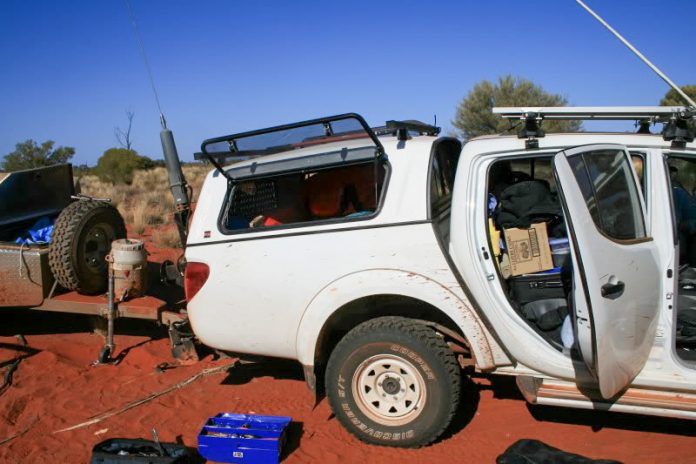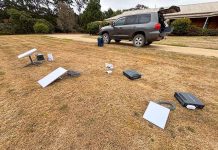The other day, my wife and I were driving along Milleria Road in Melbourne’s inner west when we pulled up alongside a dual-cab ute. I can’t recall the make and model but it looked relatively new, except it didn’t look right. When we stopped alongside it, we both looked and immediately recognised the issue. It had a bent chassis.
The first time I’d heard about this issue was when friends of ours were travelling in the Simpson Desert in their Mazda ute, towing a reasonably heavy camper trailer. Unfortunately, the weather had not been kind to them. Heavy rain across the area had turned the tracks into slop and mud. They had to push their vehicles pretty hard to get through. As it turned out, they pushed their Mazda a bit too hard and pulled up to find the chassis had bent.
Since then, we have noticed a steady stream of reports describing the very same thing, with a few photos going viral. Theories of the cause abounded and many arguments ensued. Today, the problem continues to manifest. In the last six years of travelling full time, we have seen at least six bent dual-cab utes driving on Australia’s roads.
It’s time we looked at this issue again.
TOP GEAR GAVE US A UTE CLUE
If you have ever watched Top Gear, you may have heard host Jeremy Clarkson talk about the issues with car manufacturers turning ordinary sedans into convertibles. In his assessment, when you remove the roof from a sedan, you take away much of its structural integrity. To fix the issue, manufacturers have to strengthen the base chassis. They do this by adding extra bracing to the frame. This not only adds considerable weight to the vehicle but it never really cures the inherent sloppiness in the chassis and the resulting vehicle doesn’t handle as well as the sedan equivalent.

If you look at any dual-cab ute, you will see that is it two ‘vehicles’ built on a single chassis. The front is like any sedan and the back is similar to a convertible. It’s a big open tub without a roof and, unlike a 4WD station wagon, there is nothing connecting the two halves except the chassis itself. This creates a natural weak point where the chassis can flex and, under certain circumstances, bend.
ARCHIMEDES, LEVERS AND A COAT HANGER
The Greek mathematician Archimedes once said, “Give me a lever long enough… and I will move the world.” The rear half of a dual-cab ute can be described as a third-class lever where the fulcrum (or pivot point) is located at the point along the chassis where the two halves of the ute meet. The effort to lift the load is provided by the suspension and the load is located along the other side of the chassis. You can see what I mean in the diagram below.
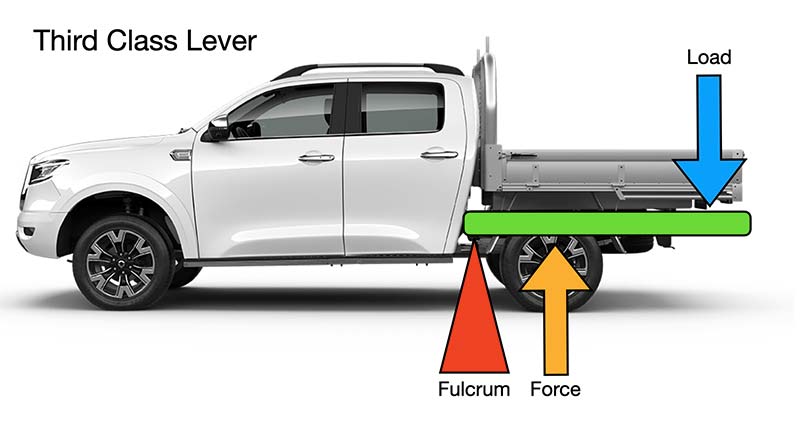
As you increase the load, you need to apply more upward force to prevent the load from falling. The further away from the fulcrum the weight is placed, the more effort will be required to lift it. This is done by either the progressive rebound in the suspension springs or by adding stiffer springs to the suspension. But there comes a point where you cannot provide enough force to prevent the load from falling, and this is where the issues start.
Take a straight length of coat hanger wire and hold it at a point one quarter along the wire. Now push on the opposite end of the wire with gentle pressure. The wire will bend and return to straight when you release the pressure. Now push on it with more force and you will find a point at which the wire bends. This action is very similar to what’s happening to the chassis of a dual-cab ute.

As you increase the load in the tub or add heavier items towards the rear of the tub, you get to a point where the suspension bottoms out at the bump stops. As you drive along, you’re hitting irregularities in the road surface. This bouncing up and down of the load flexes the chassis at the weak point and, eventually, you hit a large enough irregularity and the chassis bends.
I HEARD AIRBAGS CAUSE DUAL CAB UTES TO BEND
This is a common misconception and one that is often spouted when the subject of bent dual-cabs appears on social media. The truth is, there are plenty of examples of bent dual-cabs both with and without airbags fitted. That said, I do believe airbags are not completely without blame.
The primary reason owners of dual-cab utes fit airbags to their suspension is to prevent the OEM suspension from sagging under load. This lulls them into a false belief their vehicle can now carry more weight than it was originally designed for. Adding more gear only serves to exacerbate the underlying issue.
SO WHAT’S THE SOLUTION?
Let’s look at a third-class lever and how you improve its efficiency. You do that by either moving the load closer to the fulcrum or you move the force out closer to the load. Applying that theory to our ute means we either move the load closer to the front of the vehicle or we extend the chassis so the wheels are located in the middle of the tray.
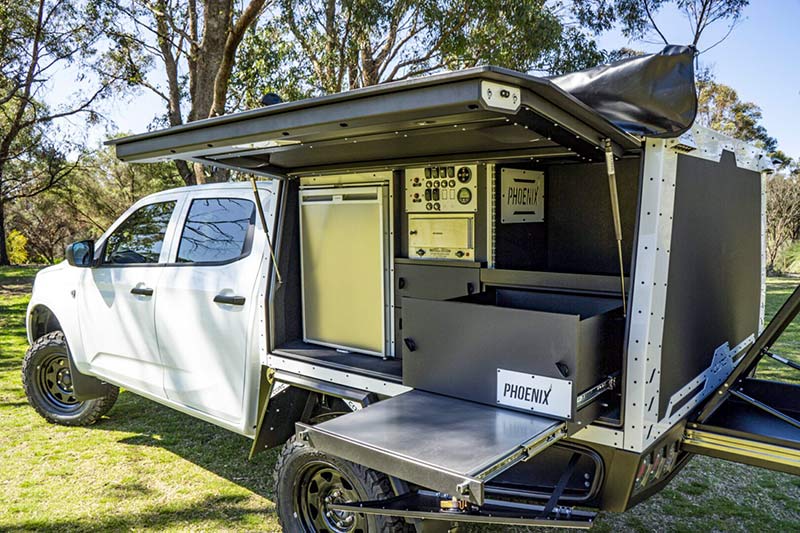
Extending the chassis is an expensive exercise that also comes with its own complications. If that’s not a solution for you, here are our six recommendations to avoid bending your dual cab ute:
1. Understand that bending of the chassis is the exception, not the rule. The overwhelming majority of dual-cab utes on the road are travelling around the country, carrying loads, towing heavy trailers and going offroad without any issue at all. So the design is sound. That said, you do have to keep in mind the vulnerability does exist and you have to treat your vehicle in such a way that you don’t exceed its capabilities.
2. Correct loading is vital. You must pack heavier items as close to the front of the tray/tub as possible. This puts the majority of the load over, or close to, the rear wheels where it is less affected by movement in the vehicle.
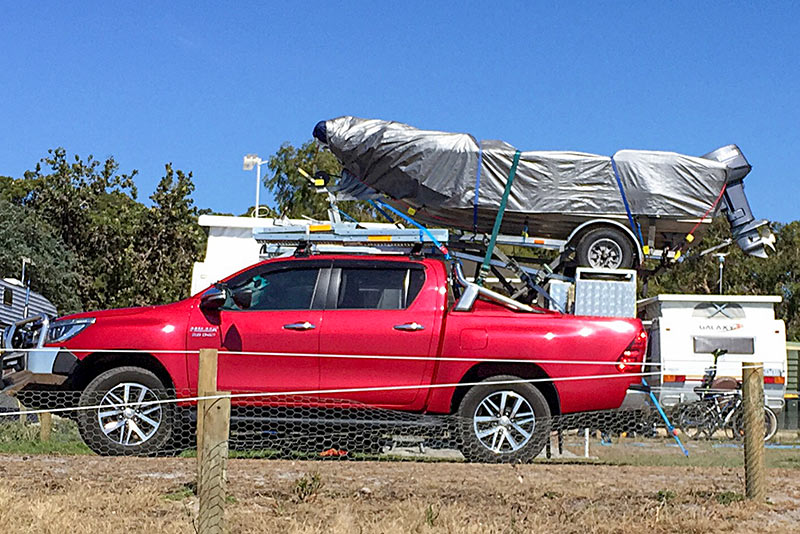
3. If you’re going to fit a canopy to your ute, have a look at the design and layout and see if it is configured in such a way that you can pack heavier items in the front section. Fridges, generators, and heavy toolboxes should all have storage areas towards the front of the canopy.
4. Be very weary of canopies where the spare tyres are stored on the back. This is the worst position to store these heavy items. It’s the furthest distance away from the weak point and subject to the most vertical movement.
5. If you want to tow a trailer, look at fitting a towbar that is as short as practically possible. I’ve seen many towbars on dual cab utes that are unnecessarily long, placing a potentially high towball load as far away from the wheels as possible. Any reduction in this distance, no matter how small, will have a positive effect.
6. If you’re driving offroad and towing a caravan or camper, take great care and avoid hitting any obstacles at speed. Beach-driving is particularly high risk. Wash-aways in the sand caused by flowing water are often difficult to see, especially if you’re driving at relatively high speeds. Slow down, drive to the conditions and encourage your passengers to watch out for any hazards you might miss.
Dual-cab utes are extremely versatile vehicles that are ideally suited to the recreational lifestyle but they are not indestructible. Like all other types of vehicles, they have their vulnerabilities. Once you understand this and set-up the vehicle accordingly, it will survive and serve you well for many years.


